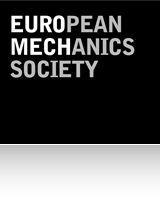596 – Numerical simulations of flows with particles, bubbles and droplets
Chairperson:
Prof Luca Brandt
KTH Mechanics
SE 100 44, Stockholm
Sweden
email: luca@mech.kth.se
Co-chairperson
Prof .Francesco Picano
Department of Industrial Engineering
University of Padova
Via Venezia 1, 35131
Padova, Italy
Dr. Outi Tammisola
KTH Mechanics, Stockholm
SE 100 44, Stockholm
Sweden
The aim of the colloquium is to review and discuss the latest advancement in numerical simulations of flows with particles, bubbles and droplets. Indeed, the development of high-fidelity numerical algorithms and computational power has recently enabled fully resolved simulations of suspensions of rigid and deformable particles, two-fluid systems and elastic/porous media, including heat and mass transfer, phase change and different short-range interactions, e.g. depletion forces. These studies are becoming more frequent and have received a significant attention. As an example, we mention the fact that at least 4 Focus of Fluids papers on the Journal of Fluid Mechanics highlighted interface resolved simulations of multiphase flows such as sediment transport, wall-bounded turbulence of neutrally-buoyant particle suspensions, rheology of capsules and droplets in homogeneous and isotropic turbulence. It is well recognised that the biggest new development in multiphase flow research have been the use of interface-resolved simulations and that these simulations are already starting to have a major impact. However, we are still exploring their potential and there are therefore plenty of opportunities to improve our understanding of the different physical processes involved. The challenge is to exploit at best the new capabilities, collect results for more and more complex systems and to advance the modelling of these systems.
Fluids with a dispersed phase are multiscale by nature, as the physics at the microscale affects the macroscopic behaviour of the flow and vice versa giving rise to surprising and fascinating phenomena as well as making this one of the most important practical problem still to solve. Investigating the mechanisms by which the system microstructure determines the macroscopic flow properties and vice versa will give valuable insights into the nature of flowing suspensions and also lead to new ways to model and control the flow. To break new ground in a field of obvious broad engineering interests we need to solve some fundamental scientific problems in non-equilibrium physics and understand, among others, the role of the fluctuations induced by the suspended phase and their coupling to the mean flow. The effect of inertia and the modifications of the interactions when increasing the shear rates. Fundamental is also an understanding of the local concentration, migration and segregation of the suspended phase on the flow properties.
The objective of the discussions to be held at the colloquium will be to identify the main challenges ahead of us. In particular, in terms of unresolved scientific questions, physics-based closures such as repulsive and attractive forces within the dispersed phase, lubrication and collision models to be included in the numerical algorithm. In addition, the participants will reflect on the best use of the large datasets now available, e.g. for upscaling procedures, as well as possible validations and efficient use of the increasingly available computational resources.
